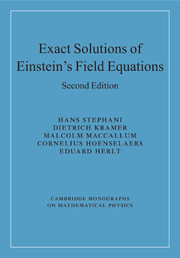Book contents
- Frontmatter
- Contents
- Preface
- List of tables
- Notation
- 1 Introduction
- Part I General methods
- Part II Solutions with groups of motions
- 11 Classification of solutions with isometries or homotheties
- 12 Homogeneous space-times
- 13 Hypersurface-homogeneous space-times
- 14 Spatially-homogeneous perfect fluid cosmologies
- 15 Groups G3 on non-null orbits V2. Spherical and plane symmetry
- 16 Spherically-symmetric perfect fluid solutions
- 17 Groups G2 and G1 on non-null orbits
- 18 Stationary gravitational fields
- 19 Stationary axisymmetric fields: basic concepts and field equations
- 20 Stationary axisymmetric vacuum solutions
- 21 Non-empty stationary axisymmetric solutions
- 22 Groups G2I on spacelike orbits: cylindrical symmetry
- 23 Inhomogeneous perfect fluid solutions with symmetry
- 24 Groups on null orbits. Plane waves
- 25 Collision of plane waves
- Part III Algebraically special solutions
- Part IV Special methods
- Part V Tables
- References
- Index
11 - Classification of solutions with isometries or homotheties
from Part II - Solutions with groups of motions
Published online by Cambridge University Press: 10 November 2009
- Frontmatter
- Contents
- Preface
- List of tables
- Notation
- 1 Introduction
- Part I General methods
- Part II Solutions with groups of motions
- 11 Classification of solutions with isometries or homotheties
- 12 Homogeneous space-times
- 13 Hypersurface-homogeneous space-times
- 14 Spatially-homogeneous perfect fluid cosmologies
- 15 Groups G3 on non-null orbits V2. Spherical and plane symmetry
- 16 Spherically-symmetric perfect fluid solutions
- 17 Groups G2 and G1 on non-null orbits
- 18 Stationary gravitational fields
- 19 Stationary axisymmetric fields: basic concepts and field equations
- 20 Stationary axisymmetric vacuum solutions
- 21 Non-empty stationary axisymmetric solutions
- 22 Groups G2I on spacelike orbits: cylindrical symmetry
- 23 Inhomogeneous perfect fluid solutions with symmetry
- 24 Groups on null orbits. Plane waves
- 25 Collision of plane waves
- Part III Algebraically special solutions
- Part IV Special methods
- Part V Tables
- References
- Index
Summary
The possible space-times with isometries
In specifying the symmetry properties of a metric one has to state the dimension of the maximal group of motions or homotheties, its algebraic structure, and the nature and dimension of its orbits. For this purpose we shall, as in §8.4, use the following notation: the symbols S, T and N will denote, respectively, spacelike, timelike and null orbits, and will be followed by a subscript giving the dimension. If an isometry group is transitive on the whole manifold V4, the space-time will be said to be homogeneous. If an isometry group is transitive on S3, T3 or N3, the spacetime will be called hypersurface-homogeneous (or, respectively, spatiallyhomogeneous, time-homogeneous, or null-homogeneous).
Petrov (1966) and his colleagues were the first to give a systematic treatment of metrics with isometries, and we therefore inevitably recover many of Petrov's results in the following chapters.
It turns out that if the orbits are null, the construction of the metric and the understanding of its properties have to be achieved by a rather different method from that used when the orbits are non-null. Accordingly we give first the discussion of non-null orbits (Chapters 12–22) and later the discussion of null orbits (Chapter 24). Within this broad division we proceed in order of decreasing dimension of the orbits.
- Type
- Chapter
- Information
- Exact Solutions of Einstein's Field Equations , pp. 157 - 170Publisher: Cambridge University PressPrint publication year: 2003



